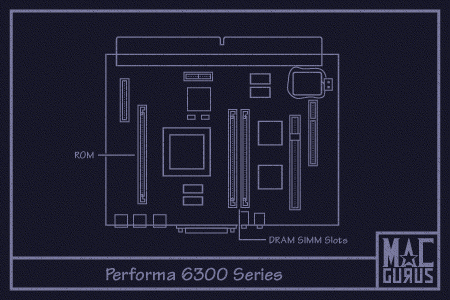


The Power Mac and Performa 6300-series include the P6300CD, the P6320CD, and --in numerical naming convention at least-- the P6360. While the P6300's Motorola 603e microprocessor runs at 100MHz, the P6320's runs at 120MHz. These two variants of the Performa 6300-series share a common logic board architecture with two (2) 72-pin slots and a 32-bit data bus. The Performa 6360, on the other hand, is based on Apple's Alchemy motherboard, bearing therefore a much closer resemblance to the Performa 5400 and Performa 6400.In fact, the architectural distinctions between the P6300-P6320 motherboard design and the P6360 design are so fundamental that they prevent these motherboards from being considered within the same familial context at all. The only point of commonality between them is that the Performa 6360 motherboard also fits, in terms of form factor, inside the same case design that has also housed the Performa 630-series motherboards. For purposes of this discussion, the expression "Performa 6300-series" refers solely to the P6300 and P6320.
As there is no DRAM soldered to the logic board, the 6300-series--exclusive of the P6360--requires that at least one SIMM be installed for the computer to boot. SIMMs may be installed in any slot, in any order, and in any size, with supported memory configurations including 8MB, 12MB, 16MB, 20MB, 24MB, 32MB, 36MB, 40MB, 48MB and 64MB. Since this logic board does not have a 64-bit data path, there is no need to install SIMMs in pairs, as in earlier generations of Power Macintosh. The maximum amount of usable memory in the 6300-series is 64MB, in the form of two (2) 32MB SIMMs.
This computer requires standard 80ns non-parity SIMMs or faster, in either 2k or 4k refresh, and typically ships with either an 8MB or 16MB SIMM in one of the SIMM slots.
Note:
Installing a SIMM in the slot adjacent to the microprocessor requires removal of the processor heat sink. The procedure is straightforward, entailing inversion of the motherboard, and manipulation of the four corner heat sink tabs. Ensure you replace the heat sink before operating this computer!This motherboard does not support memory interleaving. It should also be noted that Apple service documentation points out that the LC-style PDS slot is "not a true PDS," even though it supports many PDS devices designed for the 96/114-pin internal expansion slot originally seen on motherboards based on the Motorola 68030 microprocessor. "PDS cards," Apple comments, "designed to interact with the main processor," will not work in this slot. Examples include RAM cache or FPU cards.
As is the case with the Power Mac 5215, L2 cache comes preinstalled in the form of a proprietary Apple SIMM that also hosts ROM ICs on its reverse side. Article Mac Performa 5200 6200 FAQ (TECHINFO-0018928) from Apple's Technical Information Library (TIL) confirms the unavailability of third-party L2 cache SIMMs for this motherboard in general, and the unavailability of appropriate Apple-manufactured L2 cache SIMMs in capacities larger than 256k. Replacement pieces, in the event of defect, must also be ordered through Apple Authorized Service Providers.
Specifications Logic Board RAM None. Supported SIMMs 8MB, 16MB, 32MB. Number SIMM Slots Two (2). Supported VRAM 1MB non-upgradeable, soldered DRAM frame buffer. Number VRAM Slots None. L2 Cache Supported 256k on proprietary Apple SIMM module. SIMM Type 72-pin, FPM 32-bit, 2k or 4k refresh, 80ns or faster.
While some of the products mentioned on this page may no longer be available, the information about these products remains available to those who may need it.
As noted, the 6300-series utilizes a 1MB DRAM video frame buffer, and consequently has no VRAM slots on the logic board. No expansion beyond the 1MB video frame buffer soldered on the logic board is feasible. It is possible, however, to install video cards in the LC-style PDS slot of these computers, affording access to higher video resolutions, and permitting use of larger monitors in addition to their built-in video displays.